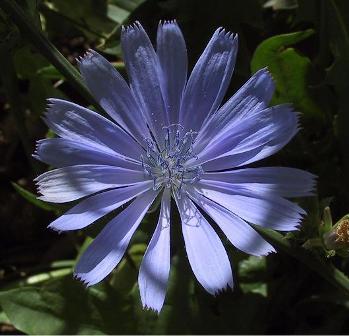Since we (Catherine, John, Ian) have lived on this farm
(since 1974), our perception of the place has changed several times.
Early on, we occupied the house and used the barn (for
chickens, geese, goats, and horses) while John and Catherine commuted to jobs
elsewhere and Ian bussed to and from the local school. We had little awareness of the place. We weren't farmers. We were apartment-dwellers who had moved to
the country. It was our 'place to stay,
with weedy fields around it.' The
attention we gave went to the log farmhouse, remodeling it according to our
ideas of loghouse living. However, even
then, perception of the surrounding grounds shifted when, around 1976, we took a wild medicinal and food foraging
class led by Evelyn Snook, Keith Wilson, and Bill Russell thru Penn State's
Free University. ("Stalking the
Wild Asparagus" was the idea.) As a
result of that experience, the outdoors took on a special interest. The weedy fields suddenly seemed a
'farmacopoeia' of useful plants for eating and for healthcare. With Evelyn's and our plant-knowledgeable
friends' encouragement, we began to pay attention to coltsfoot, golden seal,
stinging nettles, skullcap for health care, added ground cherries to salads,
and steamed lambsquarters and dandelions for side dishes. (Nothing like Evelyn's and friends'
creativity, but it was a change for us.)
We had a glimmer that plants required particular growing conditions
('habitat'' was not yet the term, but it was the recognition), but we didn't
think much about it.
In the late1990s, James Lesher began working with us, bringing
his eye as a landscape architect, his skills as a gardner, and knowledge of
plants. What decided his willingness to
work with the place, he told us later, was not us. It was a plant, the red Canada lillies growing
one of the streams ('mountain runs') as he noticed driving in the farm lane the
first time. He wanted to know more about the place where this rare (red color)
lily grew. Over some 15 years
now, James' artist's eye, skilled
hands, and experience as groundskeeper at Rhoneymede (a historic farm and art
garden nearby) has added to our emerging idea of the place as a 'landscape' and to our aim of
encouraging 'native' plants in it. This
was the 'garden' phase of perception.
(We had small vegetable gardens for a year or two, but not for
long. We started and have maintained a
kitchen herb bed. The combination of native/nonnative occurs in beds all around
the house and barn as well as in wooded areas.
This phase of perception is ongoing, while becoming better informed.) Meanwhile, we still perceived the place
primarily as a 'farm,' with tillable fields rented to neighboring farmers for
crop production and we (the 'hobby farmers') gardening isolated patches of it.
These relatively subtle perceptual shifts between
1974-approximately 2005 occurred within the frame of 'farm,' or
agriculture. In that frame, locations on
the farm had value according to their usefulness or attractiveness to us or to
renter-farmers. Wet locations, for
example, were ignored because they were
not useful or they required special treatment (usually more work) to make them
useful.
Around 2005, we
stopped renting fields for farming. The
farm entered a post-agriculture life, in our minds. (Meanwhile, without our noticing as it
happened, the formerly open, grassy,
pastured hillside had gowrn up in a new, successional forest of elms and other
trees along with brushy multiflora rose, autumn olive, etc.) Gradually, we introduced 'conservation'
practices of reforestation, wetland restoration and construction, prairie
grassland development, plant and animal habitat improvement, and others. Wet places became most interesting. In this phase, Pennsylvania and US agents in
government roles as biologists, wildlife managers, watershed specialists, and
others are our educators and helpers.
This relatively strong perceptual shift is still
growing strongly. Ecology is the new
frame and 'old farm ecology' is our working concept. 'Sense of place' is evolving. Now in 2012, we're fully in frame of trying
to understand the place. Related, we're
trying to recognize our impacts on it and the ways we and it change
reciprocally, in tandem.
As one activity in
that frame, we're tracing the place-people ('what the people living there then
did on it and with it') in time. We're
trying to learn how place and people interacted over roughly two centuries
(recorded) before we came on the place,
roughly 1760s to 1970s before us, then in our time 1974-present. James is now using his historical research
skills, examining records of various kinds
for references to land and water use or vegetation (forests, other plants) over
time. He and Catherine are gaining
momentum in understanding the reciprocal impacts of people and place over
several time scales. John is building a
website for the place that, among other functions, archives and invites
discussion of our progress in historical study. This blog entry is a way of opening the
discussion.
As James has pored
over deeds, tax records, maps, atlases, and aerial photographs in times prior
to 1974 when we took occupancy of the place, he has initiated several
thought-provoking ideas that are directing subsequent research:
- 'heritage forest (remnant woods on our property and
surrounding properties of "The Pines,' a feature prominently marked for
the area on the 1861 Tilden map (the first map) of Centre County). Relates to nearby place names such as Green
Grove Road.
- 'improved' land (indicator of change in land use such as
clearing woods to create farmfields.
Example: tax records for '200 acres, 10 improved').
- 'released' or 'returned' fields (post-agriculture
conservation)
